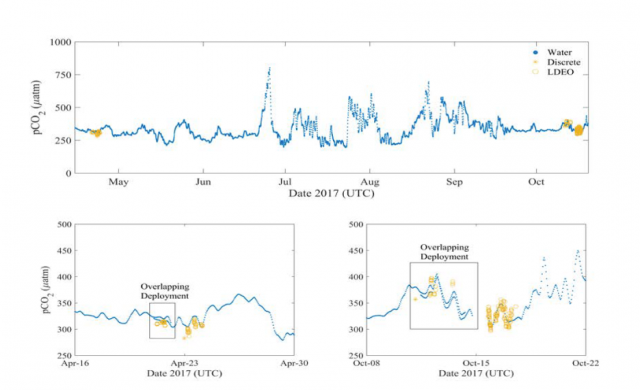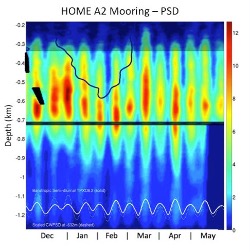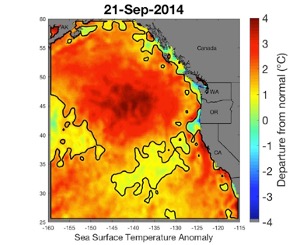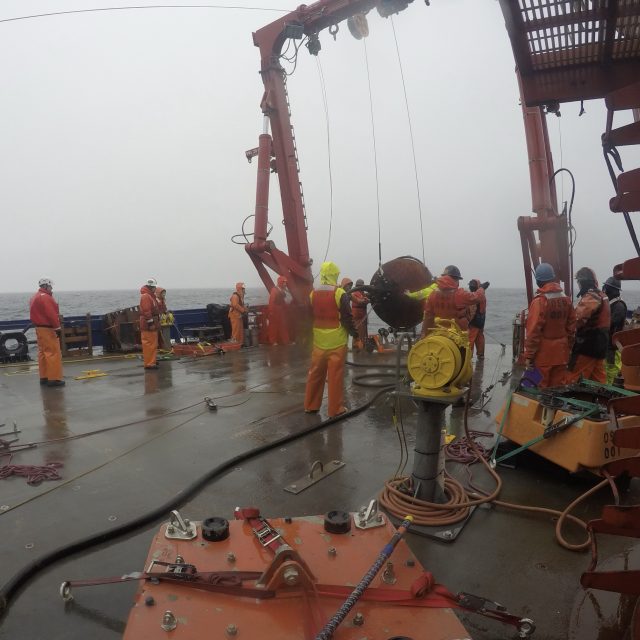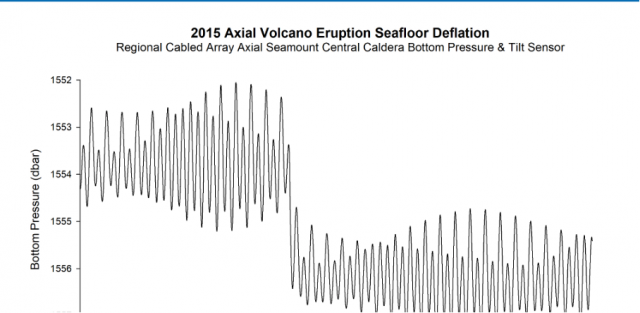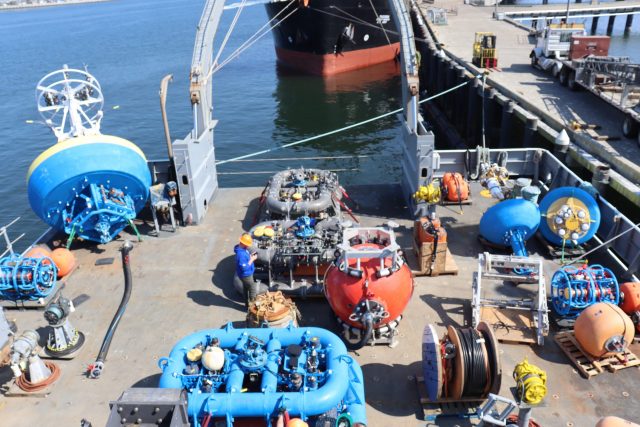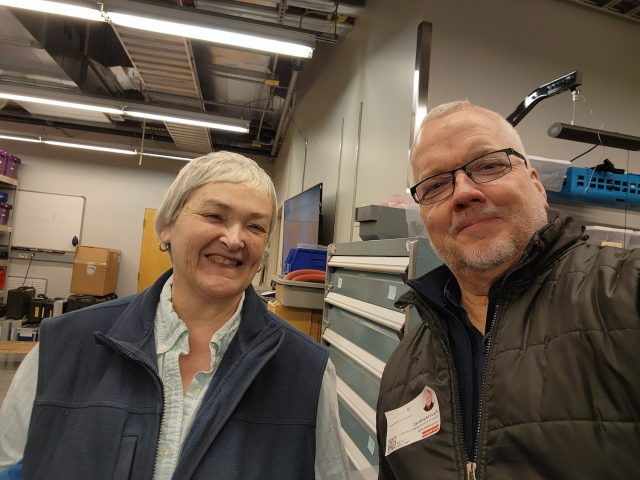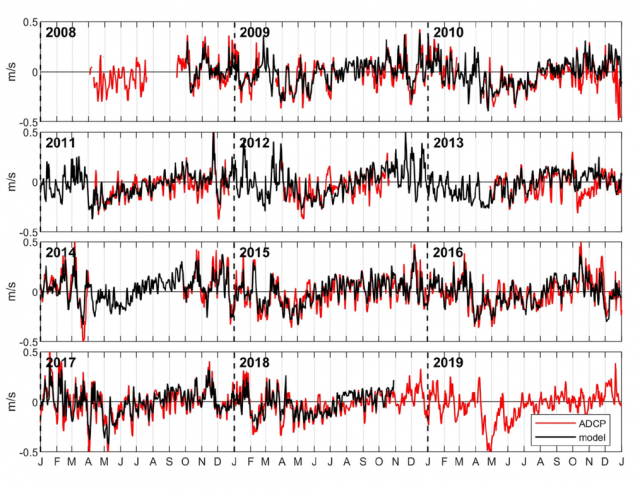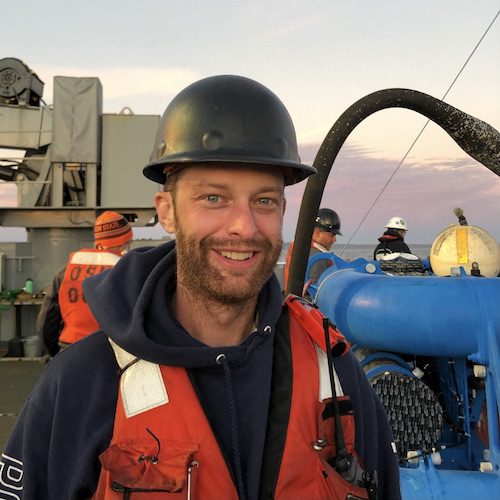Posts Tagged ‘Coastal Endurance Array’
Identifying Impacts of Ocean Acidification and Hypoxia
Ocean acidification has emerged as a leading threat to marine ecosystems, and the fisheries and shellfish growers that depend on a productive and vibrant ocean. The Coastal Endurance Array in the Pacific Northwest array is situated in an epicenter for early impacts from the co-occurrence of ocean acidification and hypoxia.
Read MoreInternal Tide Impacts on Ocean Circulation
Internal tides (ITs) have critical roles in determining the meridional overturning circulation and oceanic heat budget. The Regional Cabled and Coastal Endurance Arrays data are making it possible to identify the impacts of changes associated with the ITs.
Read MoreMarine Heatwaves
The Coastal Endurance, the Regional Cabled, and the Global Station Papa Arrays were key in identifying and monitoring the approach of a marine heatwave known as the “Blob” and its links to multiple ecosystem impacts on the US west coast.
Read MoreMission Accomplished Despite Weather
Thirteen days at sea. Two weather days. Wave heights that ranged from 2 – 12 ft, with most days somewhere around 7 foot waves. Winds from a pleasant 5 knots to days with up to 35 knots, with higher intermittent gusts. Except for two days when the sun shone, the weather was damp, cloudy, rainy, with an occasional wintery mix. Despite the conditions, the Endurance Team 18 accomplished its main mission objectives.
Much of the experience for those aboard the R/V Sikuliaq for the 18th turn of the Coastal Endurance Array focused on the weather, which presented operational challenges and less-than-ideal working conditions on some days with wintery conditions. Yet it was unseasonably mild for March. The team did a great job of taking advantage of good weather windows and, when needed, donned foul weather gear and kept at it for the duration of the expedition.
[media-caption path="https://oceanobservatories.org/wp-content/uploads/2023/03/recoveryinRain-1.jpeg" link="#"]Not required: sunscreen. Required: a good set of foulies, dry socks, and breaks for hot chow and beverages. The Endurance 18 expedition experienced less-than-ideal weather during this late winter recovery and deployment mission. Credit: Jonathan Fram, OSU.[/media-caption]“I can’t say enough about the professionalism of our team, and the crew of the R/V Sikuliaq,” said Jonathan Fram, Chief Scientist for Endurance 18, and project manager for the Coastal Endurance Array. “We literally weathered storms together to ensure a timely recovery and deployment of the Coastal Endurance Array. Everyone worked safely, without complaint to get the job done. “
Every six months, the Endurance Array Team heads to sea off the coast of Washington and Oregon to recover ocean observing equipment that has been in the water reporting data. This time, the expedition happened earlier in the year, in late winter rather than in early spring. This timing could have been compounded this year by the atmospheric rivers on the west coast of the US, but luckily the associated storms stayed south of the Endurance Array.
Nonetheless, the Endurance 18 succeeded. They recovered and deployed seven moorings, recovered two gliders, and deployed four gliders on the array. The team also deployed a coastal surface piercing profiler. Working with a remotely operated vehicle, the team was able to locate and recover an anchor that was stuck on the bottom.
[media-caption path="https://oceanobservatories.org/wp-content/uploads/2023/03/Anchor-clip-2.jpg" link="#"]A remotely operated vehicle was used to recover one of the mooring’s anchors that was stuck on the bottom. The ROV remote arm was used to clip on to the anchor and an onboard winch pulled it onboard. Credit: Alex Wick, OSU.[/media-caption]The expedition had a few non-weather-related novel components, as well. During leg two, University of South Carolina researcher Eric Tappa led the recovery and deployment of a sediment trap adjacent to OOI’s Oregon Slope Base site. This was the fourth time the sediment traps were deployed as part of Oregon State University Professor Jennifer Fehrenbacher’s and University of South Carolina Professor Claudia Benitez-Nelson’s work reconstructing ocean circulation, temperature, and chemistry in the past from sediment collected.
Each leg of the trip also had a new University-National Oceanographic Laboratory System (UNOLS) cruise volunteer and an OSU undergraduate, employed by OOI to help with the refurbishment of moorings, onboard. Such seagoing experience is invaluable to those deciding on future career paths. Listen to what UNOLS volunteer Olana Costa and OSU Undergraduate Athena Abramhamsen have to say about their experiences.
Last but not least, during leg two, OSU science videographer Kimberly Kenny recorded onboard work and shared her experiences in multiple videos and images that can be seen here and here.
“Regardless of conditions, there is nothing like being at sea with an energetic, committed group of colleagues,” said Fram. “Time at sea provides a unique opportunity to re-enforce the importance of our work to provide data to help better understand some of the changes taking place in the ocean.”
Read More
Making the Ocean Accessible Through Sound
“Scientists are finding that people can sometimes pick up more information from their ears than the eyes can see. And ears can perceive patterns in the data that the eyes can’t see,” said Amy Bower, a Senior Scientist at Woods Hole Oceanographic Institution and Principal Investigator for the Accessible Oceans project. “Adding sound to science allows more people to experience science, follow their curiosity, and make science more accessible to all. “
Bower joined forces with a multidisciplinary team to explore ways sound could be used to visualize data. Funded by the National Science Foundation’s Advancing Informal STEM Learning Program, Bower and her team have been working for nearly two years on Accessible Oceans: Exploring Ocean Data through Sound. Their goal is to inclusively design and pilot auditory displays of real ocean data. They are implementing a process called sonification, assigning sound to data points. Each member brings expertise to the task at hand. Principal Investigator Bower is an oceanographer. Dr. Jon Bellona is a sound designer with specialization in data sonification at the University of Oregon. Dr. Jessica Roberts and graduate student Huaigu Li, both at Georgia Tech, are Learning Sciences and human-computer interaction experts. Dr. Leslie Smith, an oceanographer and specialist in ocean science education and communication at Your Ocean Consulting, Inc., rounds out the team. Bower is a blind scientist, who lends a crucial perspective in the research and overall execution of the project.
To begin, the team chose to use datasets collected by the Ocean Observatories Initiative (OOI) that had previously been transformed into classroom-ready use by Smith and the Ocean Data Labs. The team is working first on three of these curated datasets: the 2015 eruption of Axial Seamount, the vertical migration of zooplankton during an eclipse event, and carbon dioxide exchange between the ocean and the atmosphere.
“Data is made of numbers. Sonification is basically just translating numbers into sound,” Bower explained. “So instead of seeing numbers go up and down on a graph, for example, you can hear them go up and down.”
To ensure an inclusive final product, the team has undertaken a co-design process in which a variety of stakeholders have been engaged for input throughout the process. The team interviewed both subject matter experts and teachers of the blind and visually impaired to ensure that both scientific and pedagogical needs were being met. They then explored the integration of various auditory display techniques and ended up with a mix of data sonification, narration, and environmental sounds. The team put together a sample of five to six sonification examples for each data set, then surveyed a group of blind, visually impaired and sighted adults and students with science and non-science backgrounds. The survey’s purpose was to ask which sounds and which approaches might work best for both sighted and visually impaired listeners.
“We asked, for example, which of these sounds do you think best represents gases coming in and out of the ocean. The feedback was overwhelmingly in favor of a breathing sound,” said Bower. “As listeners will hear in the first example below that deals with carbon dioxide exchange between the ocean and the atmosphere, the breathing sound, with narration explaining what to expect, really brings the data to life.”
Accessible Oceans is a pilot and feasibility study for a museum exhibit that would introduce the broader public to what it’s like to experience ocean data through sound. At the end of this two-year project, the team intends to submit another proposal to design and build an exhibit that make ocean data come alive in a new and accessible way.
“As we’ve been working on this project, we’ve come to realize that to engage more people in science, technology, engineering and math, we can appeal to their ears as well as their eyes,” added Bower. “And I’m determined to help make science as accessible as possible for everyone.”
________________________________________________________________________
To hear more about Amy Bower’s work as an oceanographer and her exploration of sonification, tune into this episode of The Science of Ocean Sounds, Tumble Science Podcast for Kids.
Read More
Eighteenth Turn of the Coastal Endurance Array
On Tuesday March 7th, 11 hearty scientists and engineers from Oregon State University (OSU) are heading out to the northeast Pacific aboard the R/V Sikuliaq to recover and deploy (turn) the Coastal Endurance Array. For some of the team members, this will be the eighteenth time they have made this journey to ensure that the Coastal Endurance Array continues to report data from this important region.
The array is in an important region with coastal upwelling, where strong winds cause surface waters to be pushed offshore and water from the ocean depths is pulled up – or upwelled – to the surface to take its place. These regions comprise less than 5 percent of the ocean’s surface area, yet account for a quarter of the global fish catch. The Endurance Array has been collecting data in this region since 2016, which scientists have used to examine ocean health issues, including hypoxia, ocean acidification, and how they affect ocean life.
[media-caption path="https://oceanobservatories.org/wp-content/uploads/2023/03/IMG_6460-scaled.jpg" link="#"]The Endurance 18 will be deploying seven moorings, six gliders, and four coastal surface piercing profilers, which requires the expedition to be conducted in two legs because of space limitations on the stern. Credit: Darlene Trew Crist ©WHOI.[/media-caption]The Endurance team will be very busy during their 16-day expedition. Because of the size of the equipment, the expedition will occur in two legs so recovered equipment can be brought back to shore and replaced with equipment to be deployed. They intend to recover and deploy seven moorings and recover two gliders, while deploying a full contingent of six gliders. Three gliders will “fly” at shallow depths of 200 meters across the shelf. Another three will travel at 1000 meters depth offshore. Weather and seas permitting, the team also plans to deploy four coastal surface piercing profilers.
The team will also be conducting water sampling before and after each deployment. They will conduct CTD (conductivity, temperature, and depth) casts at the deployment/recovery sites and carry out shipboard sampling for field validation of the platforms and sensors that will remain in the water for the next six months.
Chief Scientist, Jonathan Fram, who will lead both legs of the expedition, said, “Endurance 18 is happening earlier than our usual spring expeditions, which means we are likely to face rough seas. We have a highly experienced team, the ship has an exceptional crew, and we’ll be on a weather-hardened ship, so we will be able to make the most of our time at sea. Platforms that can be deployed from a smaller vessel may be deferred to spring if there are long weather delays on this end-of-winter expedition.”
The team had already experienced some unexpected weather as a freak snowstorm covered the ocean observing equipment in the storage area in Corvallis. The team had to “clean off the cars,” so to speak, before loading the equipment onto trucks for transport to the dock in Newport, for loading on the ship.
[media-caption path="https://oceanobservatories.org/wp-content/uploads/2023/03/Screen-Shot-2023-03-06-at-10.04.08-AM.png" link="#"]A few days before ocean observing equipment in Corvallis was set to be transported to the dock in Newport for loading onto the R/V Sikuliaq, an unexpected snowstorm made its way to Corvallis, covering the equipment in white. Credit: Jon Fram, OSU.[/media-caption]In addition to OOI’s recovery and deployment operations, during leg two, University of South Carolina researcher Eric Tappa, will lead the recovery and deployment of a sediment trap adjacent to OOI’s Oregon Slope Base site. “This is an example of how OOI tries to maximize ship time by partnering with scientists and other partners and institutions to make full use of the time at sea. We are always open to discussing ways we might advance other scientific objectives,” added Fram. (See How to Participate for more information.)
[media-caption path="https://oceanobservatories.org/wp-content/uploads/2023/03/Screen-Shot-2023-03-06-at-10.06.37-AM.png" link="#"]One technical improvement that will be deployed during Endurance 18 is a new steel frame over the solar polars to prevent damage caused by frequent sea lion visitors. This is one of many incremental technical improvements that are made to OOI arrays to optimize their operations while at sea. Credit: Jon Fram, OSU.[/media-caption]During the expedition, two University-National Oceanographic Laboratory System (UNOLS) cruise volunteers will be onboard as well as two OSU undergraduates who are employed by OOI to help with the refurbishment of moorings. An OSU videographer will also be onboard to share the ongoing work. Bookmark this site and follow along on the journey.
Read More
Visit to West Coast OOI Facilities
A group of Ocean Observatories Initiative (OOI) leaders visited OOI facilities at Oregon State University and the University of Washington last week to get a first-hand look at operations of the Coastal Endurance Array and Regional Cabled Array, respectively. National Science Foundation Program Director George Voulgaris, OOI Principal Investigator Jim Edson and Senior Program Manager Paul Matthias spent five days on the road meeting with their OOI west coast colleagues. The trip was designed to give recently appointed Voulgaris an opportunity to inspect the infrastructure and meet team members who keep the Coastal Endurance and Regional Cabled Arrays operational and reporting back data around the clock. Edson and Matthias seized the opportunity to meet in person with colleagues who they routinely see on the screen.
The following provides a glimpse of some of the activities that occurred during the trip:
[media-caption path="https://oceanobservatories.org/wp-content/uploads/2023/02/20230207_140014.jpg" link="#"]Grant Dunn, Mechanical Engineer with the Electronic & Photonic Systems Department at UW-APL (left) describes the level-wind system on the RCA profiler mooring to Dr. George Voulgaris during a tour of the RCA laboratory facilities at the University of Washington as RCA Project Manager Brian Ittig looks on. Credit: Paul K. Matthias © WHOI.[/media-caption] [media-caption path="https://oceanobservatories.org/wp-content/uploads/2023/02/20230207_144911.jpg" link="#"]Regional Cabled Array Principal Investigator Deborah Kelley (left) and OOI Senior Program Manager Paul Matthias take a selfie to commemorate their in-person visit during a tour of the RCA facilities at the University of Washington. Credit: Paul K. Matthias © WHOI.[/media-caption] [media-caption path="https://oceanobservatories.org/wp-content/uploads/2023/02/20230207_141656.jpg" link="#"]NSF Program Director George Voulgaris (from left), OOI Principal Investigator Jim Edson look on as Regional Cabled Array technicians Grant Dunn, Mechanical Engineer with the Electronic & Photonic Systems Department at UW-APL, and RCA Chief Engineer Chuck McGuire explain the engineering associated with the RCA profiler mooring during a tour of RCA’s facilities at the University of Washington. Credit: Paul K. Matthias © WHOI.[/media-caption] [media-caption path="https://oceanobservatories.org/wp-content/uploads/2023/02/20230209_123758.jpg" link="#"]NSF Program Director George Voulgaris (left) asks OSU technician Jonathan Whitefield questions about glider operations that provide critical water column data around the moorings of the Coastal Endurance Array. Credit: Paul K. Matthias © WHOI.[/media-caption] [media-caption path="https://oceanobservatories.org/wp-content/uploads/2023/02/20230207_112718.jpg" link="#"]NSF Program Director George Voulgaris (foreground) and RCA Chief Engineer Chuck McGuire discuss the RCA data monitoring systems as OOI PI Jim Edson points to real-time data on the screen being relayed by instrumentation on the Regional Cabled Array. Credit: Paul K. Matthias © WHOI.[/media-caption] [media-caption path="https://oceanobservatories.org/wp-content/uploads/2023/02/20230209_130353.jpg" link="#"]NSF Program Director George Voulgaris (left) gets a hands-on look at the multiple instruments contained on multi-function node that will sit on the bottom of the ocean floor for six months collecting data for the Coastal Endurance Array. Coastal Endurance Array Principal Investigator Ed Dever (middle) and Project Manager Jonathan Fram the functionality of each instrument during the visit to Oregon State University. Credit: Paul K. Matthias © WHOI.[/media-caption]
Read More
Slope and Shelf Flow Anomalies Off Oregon
Slope and Shelf Flow Anomalies Off Oregon Influenced by the El Niño Remote Oceanic Mechanism in 2014–2016
Adapted and condensed by OOI from Kurapov et al., 2022, doi.org/10.1029/2022JC018604.
[media-caption path="/wp-content/uploads/2023/01/Endurance-science-highlight-fixed.png" link="#"]Time series of the daily averaged meridional current component at the Oregon shelf location, averaged in the vertical between 60 and 70 m below the surface: (red) ADCP data and (black) model. Data from before 2015 come from various moorings maintained at the NH-10 site. Data after 2015 come from the OOI Oregon shelf site. The model reproduces the observed variability over the entire 10-year period very well, except for episodes in Dec 2010 and Oct 2013. Overall, no systematic biases or trends are found. See Fig. 7 Kurapov et al. (2022).[/media-caption]Kurapov et al. analyze outputs of a regional ocean circulation model to demonstrate the measurable impact of the El Niño remote oceanic forcing mechanism along the US West Coast during the major heat wave period of 2014–2016. The 2-km horizontal resolution model, based on the Regional Ocean Modeling System (ROMS), was run for the period of 2009–2018. Though the model does not assimilate observations, it performs well by comparison with time series data (including OOI data, Figure above) explaining observed variability on temporal scales from several days to seasonal and interannual.
The El Niño-related oceanic anomalies provided by a global state estimate are introduced in the regional model at the southern boundary at 24N. These propagate alongshore with coastally trapped waves (CTWs) and influence the variability off Oregon (41°–46°N). In particular, CTWs are evident in the subsurface along-slope current, vs, and in the depth of the 26.5 kg m3 isopycnal surface over the slope, z26.5. In summer 2014 and 2015, vs anomalies are positive (northward) and z26.5 anomalies are negative (deeper) along the US West Coast. In addition to the CTW patterns, z26.5 anomalies also exhibit slow-moving features associated with undercurrent widening, separation, and subsurface eddy variability. Over the Oregon shelf, El Niño conditions contributed to the sharp weakening of the southward alongshore current throughout the water column in July 2014 and 2015, despite the near-average southward, upwelling-favorable winds.
Kurapov, A. L., Rudnick, D. L., Cervantes, B. T., & Risien, C. M. (2022). Slope and shelf flow anomalies off Oregon influenced by the El Niño remote oceanic mechanism in 2014–2016. J. Geophys. Res.: Oceans, 127, e2022JC018604. doi.org/10.1029/2022JC018604.
Read MoreAlex Wick: Conducting Sea-going Operations
OOI Coastal Endurance Array Deck Lead Alex Wick has been working on ships for more than a decade. He is a classic example of learning the ropes from the bottom up. After receiving a degree in marine biology from the University of Santa Cruz, he took some scuba diving lessons, but really didn’t know what he wanted to do.
Wick started his journey aboard ships in 2012 sorting tools for a marine technician onboard the R/V Point Sur, out of Moss Landing, California. When offered the job, he had no idea what he was getting into. He showed up in shorts, street shoes, with no personal protective gear (PPE) at all, and no at-sea experience.
But he learned quickly and advanced from sorting sockets to needle-gunning the deck, which involves removing all of the old paint with a needle gun before applying a new coat of paint. This activity was when Wick was given his first set of PPE – safety glasses, knee pads, hard hat, and gloves – which gave him a real understanding of their importance during five days of back-breaking work.
[media-caption path="/wp-content/uploads/2023/01/Alex.jpeg" link="#"]Alex Wick has been deck lead for Endurance Operations since 2018. Credit: Darlene Trew Crist ©WHOI.[/media-caption]
Wick started repainting the deck of the boat. The captain, at the time, recognized Wick’s work ethic and dedication and continued to expose him to shipboard duties. From one cruise as a deck hand, he advanced to an 84-day expedition to Antarctica. He jokes that at the time he didn’t even know how to use a ratchet strap, which is widely used to secure heavy equipment on ships and elsewhere.
“The captain told me to secure a small boat under the A-frame,” said Wick. “I had no idea how to do, but figured it out. With one day of oceanographic experience under my belt, I was off to Antarctica.” As it turned out, it was the best possible hands-on learning experience for Wick, which ultimately led to him spending about 500 days at sea and his role with the Endurance Array team today.
“There was nothing like driving a boat in Antarctica with a guy with a crossbow on the bow of the boat directing me around chasing Minke whales,” added Wick. “We would come up alongside one of them, shoot a crossbow bolt into its dorsal fin to retrieve a bio-sample. I thought it was the coolest thing ever.”
This Antarctica expedition provided Wick with the foundational knowledge he now uses aboard the R/V Thomas G. Thompson during bi-annual recovery and deployment expeditions for the Coastal Endurance Array. His time on the Point Sur taught him how to run winches, use the A and J frames, which support the lifting of heavy equipment in and out of the ocean, and most importantly, how to work on a ship in a safe manner.
After Antarctica, Wick spent six years as a deck hand and marine technician, where he developed an innate understanding of how all the pieces move on deck. Jonathan Fram, who often serves as chief scientist for the Endurance expeditions likens Wick to a symphony conductor. “He directs the operations while always having an eye on each member of the ‘orchestra’ and what they should be doing at certain times. This orchestration is critical to getting the heavy equipment we deal with on and off board without incident.”
Wick moved to Oregon State University when his wife was accepted into a PhD program there. He was hired on as a marine technician on the R/V Oceanus, where he sailed for up to 100 days a year. But, a man of many interests, Wick grew tired of being away from home for such long stretches. He missed his family, mountain bike, fishing, and other activities afforded by living in Oregon. He applied for the job as deck lead with the Endurance Array team and has been on the job since December 2018.
His first trip to the dock in Newport after a fall Endurance expedition, where he saw the massive amount of equipment moved on and off the ship and in and out of the water, provided Wick with his leadership philosophy.
“I think that the person running the deck should be basically completely hands off. That way, we are able to actually observe everything and see the bigger picture of what’s happening,” said Wick. “As we’re doing recoveries or deployments, I’m always thinking of the next pieces of the puzzle. I want the folks on the back deck and on the bridge to know what to expect, so everyone knows what’s ahead and can plan for what they’re going to be doing.”
From the seeds of his earliest experience aboard the R/V Point Sur, Wick is totally committed to overseeing a safe operation. “The deck lead is responsible for everyone’s safety and making sure we’re doing things appropriately,” he explained. “Sure unexpected things can happen, but back deck operations can and should be done safely. I feel a great responsibility for making sure that everybody comes back with all their digits and we all return to shore having successfully completed the job and return to our family and friends.”
Wick’s favorite part of the job is working with the team. He joked, “We are all part of the communal suffering. Doing the same thing together. We have a lot of big toys that we get to play with safely. And, it really is special at sea. It’s cool to see the whales breaching, the dolphins racing the ship, the bioluminescence, and skies filled with stars. No matter how crusty and jaded we might be, it takes a team to put these moorings in the water, and deep down, I think we all really enjoy doing this.”
Wick has served as deck lead for six Endurance expeditions and has overseen the movement, deployment and recovery of 270 tons of scientific equipment. Not a bad record for a kid who started out sorting tools.
[media-caption path="/wp-content/uploads/2023/01/Alex-2.jpeg" link="#"]Wick choreographs the recovery and deployment of the Endurance Array moorings. Credit: Darlene Trew Crist ©WHOI. [/media-caption]
Read More
Improving Reliability and Availability of Dissolved Oxygen Glider Data
OOI’s Coastal Endurance Array Team is making great strides in ensuring the accuracy of glider dissolved oxygen measurements and making these data readily available to researchers. The team has compared glider oxygen data with independent transects and climatologies compiled by west coast colleagues. They are increasing the number of in situ comparisons of glider oxygen data with bottle samples taken in proximity to the gliders. They have built a benchtop system to do two-point calibrations for oxygen sensors to help ensure their accuracy when the gliders are in the water. And, working with OOI colleagues at WHOI, the team is helping to design and test improved sensor mounts to perform in situ air calibrations of glider oxygen measurements.
“A couple of years ago, Endurance Glider Lead Stuart Pearce developed code to put all of the oxygen data collected by our glider fleet into the DAC, the national central database for glider data,” said Ed Dever, Principal Investigator of the Coastal Endurance Array and Professor at Oregon State University. “Prior to doing this, Stuart examined the data and metadata for any gross errors and issues. That was the first of many steps we have taken to ensure OOI oxygen data are reliable and available so they can be trusted and used by researchers. Our effort is paying off. The glider data available on the DAC are identical to that now available on OOI’s Data Explorer. Endurance glider lines off Newport, OR and Grays Harbor, WA will be the backbone for the northern Californian Current part of the nascent Boundary Ocean Observing Network. The OOI glider lines map seasonal development of hypoxic areas off Oregon and Washington from the coast to the edge of the continental shelf.”
[media-caption path="/wp-content/uploads/2022/11/glider.png" link="#"]More than 137 glider missions have occurred along the Newport and Grays Harbor lines since 2014. Credit: Coastal Endurance Array at OSU.[/media-caption]
Collaborations
Enough oxygen data has been collected and shared in the northeast Pacific that is now possible to make high resolution regional climatologies of temperature, salinity and oxygen. Risien et al. (2022) compiled ~20 years of data taken by Jennifer Fisher (NOAA) and many others, to develop analysis ready transects of water property data off Newport, Oregon. These datasets include both climatologies and individual interpolated, quality-controlled, transect data. The Endurance Team compared glider dissolved oxygen with shipboard CTD samples collected by Fisher along the Newport transect in July 2021. Oxygen measurements from the gliders and CTDs samples compared well and provided confidence that glider and shipboard transects can map hypoxic conditions at comparable resolution and accuracy. Added Dever, “We were able to do a side-by-side comparison of the temperature, salinity, and oxygen data collected by the gliders over our Newport hydrographic line with the CTD data sampled by the Fisher’s team using the R/V Elakha. The comparison was quite good and served to validate the quality of the glider data that are an integral part of the Endurance Array.”
Engineering Solutions
A couple years ago, team member Jonathan Whitefield worked with Scripps Institution for Oceanography to build an oxygen Winkler titration rig so the team can titrate its own oxygen samples. The system can be used both in the lab and onboard to validate glider and moored oxygen data. The titration rig has been used to increase the number bottle samples taken during glider deployments and recoveries and to reduce the time between sample acquisition and analysis.
Building on this, Whitefield and others recently assembled in-house two-point calibration baths for pre- and post deployment of oxygen data collected by gliders and moorings. Calibrations are performed at anoxic and near-saturated conditions. The two-point calibration system is based on a similar one used at Scripps Institution for Oceanography (López-García, P., et al., 2022). A sodium sulfite solution is injected into bottle samples to get the low endpoint oxygen calibration point. The high endpoint oxygen calibration point is achieved using a stirred bath at 10°C to get to near saturation. The high endpoint oxygen is measured with replicate Winkler titrations. The calibration baths better ensure accuracy by making it possible to perform routine in-house checks of vendor calibrations on glider and moored sensors as well as identify calibration drift after deployment.
What’s ahead
Oxygen data are reviewed weekly by operators and annotated. Real-time automated quality control using QARTOD tests is in development. In-situ air calibration tests of oxygen optodes are planned for spring 2023. At the suggestion of outside investigators, OOI’s Coastal and Global Scale Node team at Woods Hole Oceanographic Institution modified Slocum glider optode mounts to allow in-situ air calibrations of dissolved oxygen on the Irminger Sea and Pioneer Arrays. The mount, however, affected the flow around gliders with radome fins and caused navigation problems. Modeling done at WHOI showed these problems may be due to vortices of the optode on the starboard side of the fin. The Endurance gliders will test a new mount placement during its upcoming bi-annual operations and maintenance cruise in March of 2023.
“We’re part of the community of practice for glider oxygen calibration and validation,” said Dever. “We engage with colleagues, adopt standard practices and widely share data. This community of users will help all of us get a better handle on ongoing changes in our ocean regions.”
References
Risien et al. (2022) Spatially gridded cross-shelf hydrographic sections and monthly climatologies from shipboard survey data collected along the Newport Hydrographic Line, 1997–2021, https://doi.org/10.1016/j.dib.2022.107922
López-García, et al. (2022) Ocean Gliders Oxygen SOP, Version 1.0.0. Ocean Gliders, 55pp. DOI: http://dx.doi.org/10.25607/OBP-1756. (GitHub Repository, Ocean Gliders Oxygen SOP.
Read More

